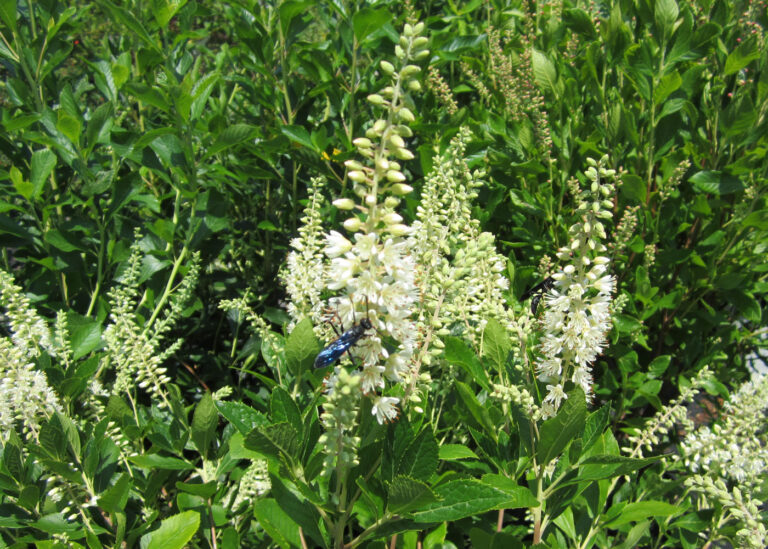Plant List: To Avoid Deer Damage

Deer Damage-
Plants prone to it and resistant to it….
Derived from Cornell Cooperative Extension Listing and other listings.
Plants listed below are offered at Ward’s during the growing season but may not currently be available. Whenever possible a specific plant is indicated using both the scientific genus and species names. Otherwise the abbreviation “sp” is used to indicate plants belonging to the entire genus in question. Not responsible for typographical errors.
Note – Deer are creatures of habit and will return to the same location where suitable food was found before. Blocking deer trails can help send them elsewhere. Property owners in Columbia County NY will need to put up fences to keep deer out of all gardens.
Download a printable PDF version of this post
Plants to protect well with repellants or avoid planting because they could ATTRACT deer:
Annuals & Biennials–
- Hollyhocks (Alcea)
- Impatiens
- Mexican Sunflower (Tithonia)
Herbaceous Perennials-
- Crocus
- Daylily (Hemerocallis)
- Hosta
- Cardinal Flower (Lobelia)
- Phlox
- Rose
- Tulips
Trees & Shrubs-
- Balsam Fir (Abies balsamea)
- Clematis
- Crabapple (Malus)
- Ornamental Cherry (Prunus)
- Rhododendrons
- Yews (Taxus)
Trees & Shrubs OCCASIONALLY damaged by deer –
Maybe avoid if you have a problem-
- Concolor Fir (Abies concolor)
- Maples (Acer sp)
- Smoke bush (Cotinus coggyria)
- Cotoneasters
- Rose of Sharon (Hibiscus syriacus)
- Hydrangea
- Eastern Red Cedar (Juniperus virginiana)
- Privet (Ligustrum)
- Oaks (Quercus sp)
- Rugosa Rose (Rosa rugosa)
- Canadian Hemlock (Tsuga canadensis
- Viburnums
Trees & Shrubs SELDOM damaged by deer-
- Buxus- Boxwood
- Caryopteris
- Chamaecyparis-Falsecypress
- Clethra-Sweet Pepperbush
- Cornus-Red Osier Dogwood
- Cornus florida-Flowering Dogwood
- Cornus kousa- Kousa Dogwod
- Enkianthus campanulatus- Red-vein Enkianthus
- Forsythia sp.- Forsythia
- Ilex glabra- Inkberry
- Juniperus chinensis- Chinese Junipers
- Kalmia latifolia- Mt. Laurel
- Kolkwitzia amabilis- Beautybush
- Leucothoe fontanesiana
- Picea abies- Norway Spruce
- Picea glauca- White Spruce
- Pieris- Japanese Andromeda
- Pinus resinosa- Red Pine
- Pinus sylvestris- Scots Pine
- Spirea- Spirea, Bridal Veil
- Syringa vulgaris- Common Lilac
Perennials that deer don’t really like:
- Achillea-Yarrows
- Alchemilla – Lady’s Mantle
- Allium – Chives, ornamental onion
- Amsonia tabernaemontana-Amsonia
- Anemone x hybrida- Japanese anemone
- Angelica Archangelica- Angelica
- Aquilegia – Columbine
- Arisaema triphyllum- Jack-in-the-Pulpit
- Artemisia- Wormwood
- Aruncus dioicus- Goatsbeard
- Asclepias tuberosa – Butterfly weed
- Astilbe- False Spirea
- Baptisia sp – False Indigo
- Bergeniea sp – Bergenia
- Boltonia asteroides – Boltonia
- Brunnera – Perennial Forget-me-not
- Buddleia davidii- Butterfly bush
- Cailuna sp. – Heather
- Campanula carpatica, clomerata and persc. – Bellflower
- Ceratostigma plumbaginoides – Plumbago
- Chelone sp – Turtlehead
- Chrysanthemum coccineum, C. superbum, C. parthenium
- Cimicifuga racemosa – Bugbane
- Coreopsis sp. – Coreopsis
- Dennstaeotia punctilobula – Hay scented fern
- Dianthus sp. – Sweet William, pinks
- Dicentra exima – Bleeding heart
- Dictamnus albus – Gas Plant
- Echinacea purpurea – purple coneflower
- Echinops- Globe Thistle
- Erica sp. – Heath
- Epimediums- Bishop’s Hat
- Eupatorium – Chocolate Boneset
- Eutrochium sp – Joe-Pye Weed
- Euphorbia sp- Spurge
- Filipendula sp-Queen-of-the-Prairie
- Fritillaria imperialis- Crown Imperial
- Geranium macrorrhizum
- Geum sp – Avens
- Gypsophila paniculata – Baby’s Breath
- Helleborus sp- Hellebore
- Iberis smpervirens-Candytuft
- Kirengeshoma plamata- Kirengeshoma
- Lavandula sp- Lavender
- Liatris spicata- Spike Gayfeather
- Lium lancifolium- Tiger lily
- Limonium latifolum- Statice
- Linaria sp.-Toadflax
- Linum perenne- Perennial Blue Flax
- Lupinus sp- Lupine
- Lythrum sp- Loosestrife
- Maticaria- Feverfew
- Matteuccia struthiopteris- Ostrich Fern
- Mentha Pulegium- Pennyroyal
- Menta sp- Mint
- Mitchella repens-Partridgeberry
- Monarda didyma-Beebalm
- Myosotis scorpiodes-Forget-me-not
- Myrrhis odorataa-Sweet Cicely
- Narcissus sp- Daffodil
- Nepeta- Catnip
- Oenothera tetragona-Sundrops
- Oenothera sp.-Evening Primrose
- Onociea sensibilis-Sensitive Fern
- Origanum sp.- Oregano
- Osmunda cinnamonmea- Cinnamon Fern
- Osmunda claytoniana- Interrupted Fern
- Osmunda regalis- Royal Fern
- Papaver orientale- Oriental Poppy
- Phalaris arundinacea ‘Picta”-Ribbon Grass
- Platycodon grandiflorus-Balloon Flower
- Polemonium caeruleum-Jacob’s Ladder
- Polystichum actostichoides- Christmas Fern
- Potentilla sp-Cinquefoil
- Priumla sp-Primrose
- Pulmonaria sp- Lungwort
- Ranunculus sp. – Buttercup
- Rheum sp-Rhubarb
- Rosmarinus officinalis- Rosemary (not hardy here – bring indoors)
- Salvia sp.- Sage
- Saponaria sp. – Soapwort
- Scilla sp.-Scilla
- Solidago sp- Goldenrod
- Stachys byzantina- Lamb’s Ear
- Tanacetum sp.- Tansy
- Thelyptens noveboracensis- New York Fern
- Thymes
- Verbascum sp.- Mullein
- Veronica latifolia- Hungarian Speedwell
- Vinca major- Greater Periwinkle
- Viola Labridorica – Labrador Violet
- Yucca sp.- Yucca
- Ornamental Grasses
Perennial groundcovers that deer don’t really like:
- Ajuga peptans- Bugleweed
- Asperula oderata- Sweet Woodruff
- Convalaria majallis- Lily-of-the-Valley
- Epimedium sp- Barrenwort
- Lamium sp-Dead Nettle
- Pachysandra terminalis- Japanese Pachysandra
- Vinca minor- Periwinkle
Annuals rarely or never eaten by deer:
- Aconitum- Monkshood (poisonous)
- Ageratum
- Antirrhinum- snapdragon
- Begonia x semperflorens-cultorum- Wax Begonia
- Cleome Hasslerana- Cleome
- Dahlia sp. – Dahlia
- Datura sp.- Thorn Apple
- Digitalis sp – Foxglove
- Gailllardia pulchella- Blanket Flower
- Heliotripium arborecens- Heliotrope
- Hypoestes phyllostachya- Polka-dot plant
- Ipomoea sp- Morning Glory
- Lobelia Erinus-Edging Lobelia
- Lobularia Maritima- Sweet Alyssum
- Mirabalis Jalapa- Four O’Clock
- Myosotis sylvatica- Forget-me-Not
- Ocimum Basilicum- Sweet Basil
- Papaver sp.- Poppy
- Pelargonium x hortorum- Zonal Geranium
- Petroselinum crispum-Parsley
- Salvia farinacea- Blue Salvia
- Senecio Cineraria- Dusty Miller
- Tagetes sp.- Marigold
- Verbena x hybrida- Verbena
Our Summer Garden Advice
By mid-summer, perennial gardens can start to look overgrown, annual flowers begin to fade, and bugs may be munching on your vegetables.
Summer Articles